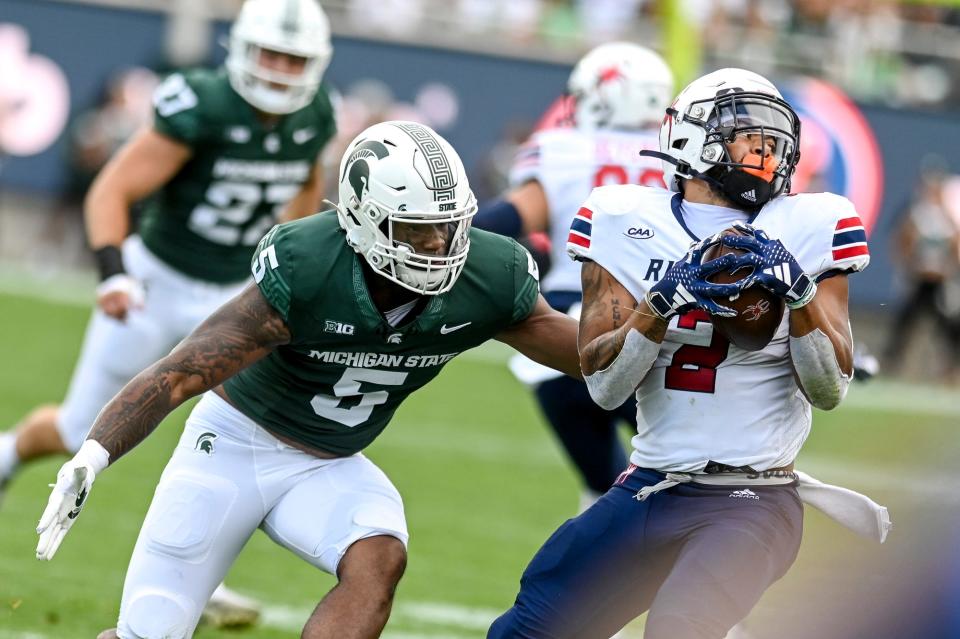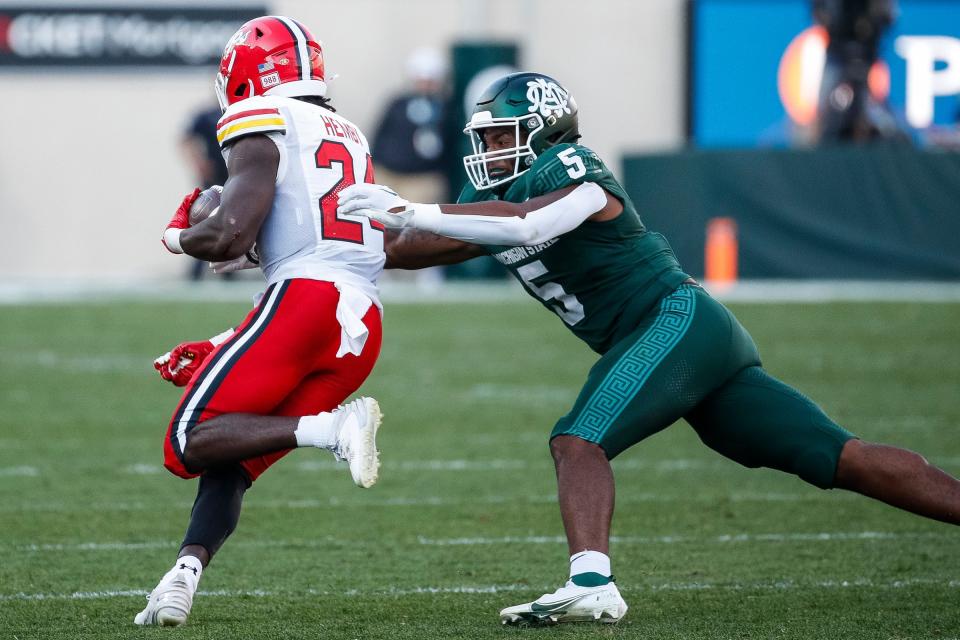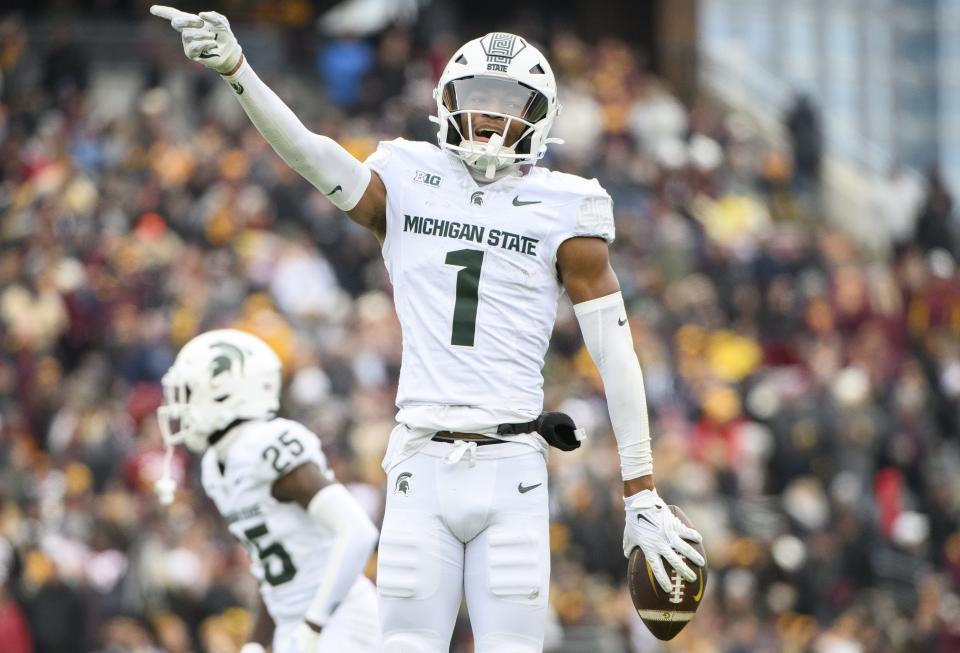Why there is hope Michigan State football defense can be reborn with 'aggressive' scheme

EAST LANSING — Jordan Hall can’t predict what it will be like when the games begin. But in the here and now, with Michigan State football in its third week of spring practice, he feels refreshed and even liberated.
“It’s really appealing,” the sophomore linebacker said, “when we’re able to play free and make plays.”
In so many words, Hall offered the latest ringing endorsement of new coordinator Joe Rossi’s malleable scheme, which Hall’s teammates have described as “downhill” and “aggressive.”
The attack-minded approach is welcomed by a scarred group of defenders who experienced one calamity after another under Rossi’s predecessor, Scottie Hazelton. During his four seasons at MSU, Hazelton ran a bend-but-not-break system that often cracked under the pressure applied by opponents that encountered little resistance. Eleven times over the course of his tenure, the Spartans conceded at least 500 yards in a game — showing the greatest vulnerabilities against the most explosive offenses. The disastrous results were as alarming as they were frustrating because Hazelton seemed stubbornly passive.

MORE FROM SABIN: MSU's new coordinators determined to create what Mel Tucker couldn't
Under his direction, cornerbacks played well off the line of scrimmage, which left receivers unguarded as they began running their routes. The thrust of the strategy was to erase any deep shots and force MSU’s competition to drive the length of the field. But in the process of creating a protective shell, the Spartans repeatedly allowed wide zones to open underneath, which opposing quarterbacks routinely exploited as they guided their teams toward the end zone.
The flawed design of Hazelton’s system led to major breakdowns, especially on third down. The trail of evidence left behind helped explained why. In the past three seasons, MSU routinely ranked among the bottom 40 teams in the number of allowed completions that covered 10 or more yards. During 2021, which marked the highest point of Mel Tucker’s ill-fated regime, the Spartans finished dead last in that category within the entire Football Bowl Subdivision. The troubling totals, which became part of a problematic trend, highlighted the shortcomings of a scheme couldn’t limit the high volume of plays MSU habitually faced.
“The defense was on the field for basically the entire game,” safety Dillon Tatum said. “So, that didn’t help at all. We were put in a lot of bad positions as a defense.”
[ MUST LISTEN: Make "Spartan Speak" your go-to Michigan State Spartans podcast, available anywhere you listen to podcasts (Apple, Spotify) ]
But there is hope that Rossi can spark a revival by seeding a better environment. At Minnesota, where he called the plays for the past six seasons, he shepherded one of the nation’s best units in 2021 and 2022. Rossi was able to extract positive results with a defense built to adhere to three core tenets: Stop the run, create takeaways and eliminate explosive plays. Hazelton often championed those same philosophical bullet points. But whereas he couldn’t create the conditions for MSU to achieve those objectives, Rossi’s track record suggests that he can.
Two years ago, the Golden Gophers finished in the top 10 in long scrimmage plays allowed and opponent’s third-down conversion rate. The success, he said, is derived from an elasticity that the dogmatic Hazelton rarely showed. Year to year, Rossi tailored his scheme to the abilities of his players. In his first season in East Lansing, he plans to take a similar tack and adapt accordingly.
“That's going to be a constant evaluation this spring is what are we good at, what are we are not,” Rossi said. “Let's lean towards the things we are good at; let's shy away from the things that are not.”
MSU PLAYERS: Vibe on the rise under 'straight-shooter' Jonathan Smith
But it’s hard to tell exactly where MSU’s strength lies. The Spartans didn’t distinguish themselves in any specific area under Hazelton’s supervision. The pass rush was average. The secondary, by and large, was underwhelming. The front seven periodically had issues stopping the run. It led to a crisis of confidence among a unit that was a weak link throughout Tucker’s tenure.
Rossi and the rest of the defensive staff will inherit a big project as a result.
“That’s the task: Getting guys to play better than they played last year,” said new secondary coach Blue Adams.
Adams believes it is an achievable mission. After all, quality contributors can be found in all sectors.
“We have talent here,” Hall insisted.
That much became apparent even as MSU bottomed out with a 4-8 record last fall during a tumultuous season marked by scandal and upheaval. Simeon Barrow and Derrick Harmon are back to provide a solid base up front. Hall, a former blue-chip recruit from IMG Academy, shows promise after he emerged as a starter during a challenging freshman season. Fifth-year linebacker Cal Haladay is still there to give MSU a veteran presence in the middle.
“And I think (safety Jaden) Mangham is a big-time player,” observed Adams.

Together, they are on the ground floor of a new venture. The novelty of it all excites the holdovers from the Tucker era, who are eager to lean forward and impose their will instead of falling backwards in constant retreat. In practice, Mangham noticed the cornerbacks have reacted positively to pressing the receivers at the line of scrimmage. Defensive tackles like Maverick Hansen have enjoyed launching from their hunched positions and penetrating the gaps instead of holding the point as they have in the past. Haladay senses the scheme switch should ease the pass coverage burdens he faced, making a point to say the differences “will be noticeable.” Hall believes Rossi’s scheme will accentuate his playmaking ability.
“As linebackers,” he said, “We always want to attack.”
Now, they have the license to do so, and it feels more natural, according to Hall.
“Just go out, play ball, get downhill and have fun,” Hall said.
Contact Rainer Sabin at rsabin@freepress.com. Follow him @RainerSabin.
This article originally appeared on Detroit Free Press: Michigan State defense sees the possibilities with new 'aggressive' scheme

